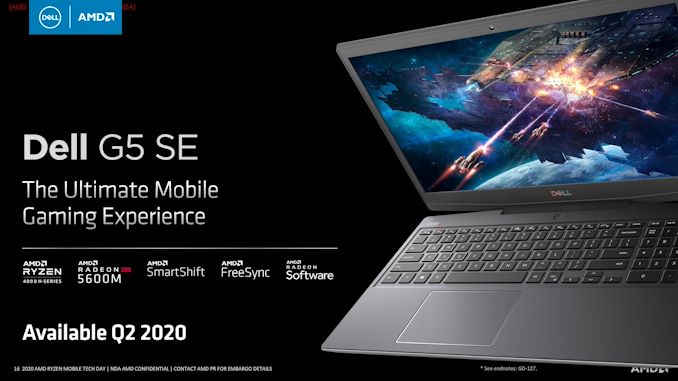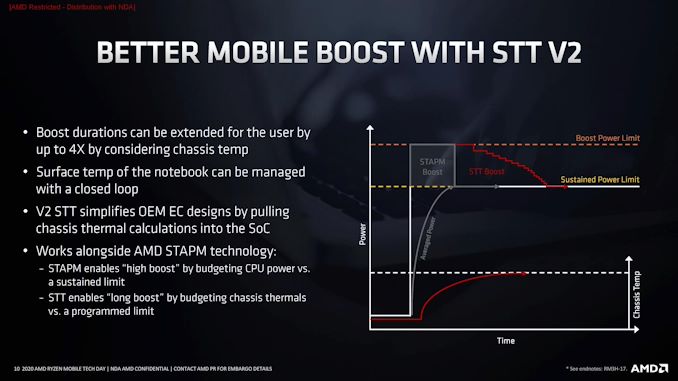AMD Details Renoir: The Ryzen Mobile 4000 Series 7nm APU Uncovered
by Dr. Ian Cutress on March 16, 2020 11:00 AM ESTAMD SmartShift
We’ve covered AMD’s SmartShift before, when it was announced at CES, as a technology that allows a system management controller to interact with both the mobile APU and an AMD graphics card in the same system in order to shift power where it is needed. This solution is still based on separate power rails between the two, however the use of the scalable control fabric (SCF) part of Infinity Fabric means that parts of the APU and parts of the GPU can interact together in this way. Ultimately AMD believes they can score 10-12% better on heavy CPU workloads like CineBench or gaming workloads like The Division.
The solution is firmware based, but requires interaction between qualified hardware. AMD states that often in these sorts of CPU+GPU designs, while the chassis has a total design TDP, if one of the elements of the system is idle, then the other can’t take advantage of the extra turbo headroom available. SmartShift aims to fix that.
What’s new here is that AMD is primarily focus will be on Ryzen Mobile 4000 + Vega 10 style systems. The first one with SmartShift enabled will be the Dell G5 SE. The Dell G5 SE is being labelled as ‘the ultimate mobile gaming experience’, and will feature a new H-series processor, the Radeon RX 5600M, SmartShift, FreeSync, and have a 15-inch display. The unit will be coming out in Q2.
System Temperature Tracking (Version 2)
SmartShift is also part of a new System Temperature Tracking paradigm that AMD is implementing in its new APUs. Even if there is power headroom, a system can’t turbo if there isn’t thermal headroom. Smart Temperature Tracing v2 (or STTv2) is designed to help a system boost for longer by knowing more about the thermal profile of the device.
My placing additional thermal probes inside the system, such as on hot controllers or discrete GPUs, the readings of these can be passed through the Infinity Fabric to an embedded management controller. Through learning how the system thermals interact when different elements are loaded, the controller can determine if the system still has headroom to stay in turbo for longer than the current methodology (AMD’s Skin Temperature Aware Power Management). This means that rather than having a small number of sensors getting a single number for the temerpature of the system, AMD takes in many more values to evaluate a thermal profile of what areas of the system are affected at what point.
What STTv2 does at the end of the day is potentially extend the boost time for a given system, depending on its thermal capabilities. For example, the Lenovo Yoga Slim 7 which we are expecting for review only has a 15 W processor inside, but the chassis has been built for a 25 W TDP design, which means that STTv2 should kick in and provide the user with peak performance for longer.














95 Comments
View All Comments
uibo - Monday, March 16, 2020 - link
HTPC market insignificantSamus - Tuesday, March 17, 2020 - link
I mean realistically there isn't anything a 10w Atom can't decode anymore...everything is overkill for HTPC.As far as encoding, for what the general consumer does (twitch, etc) any midrange CPU can handle that in the background on top of any other tasks you demand. It won't be a 10-15w part, but certainly a 35w part.
R3MF - Tuesday, March 17, 2020 - link
even AV1?bearing in mind that a new htpc has a ~6 year life and AV1 is the future of streaming video.
close - Tuesday, March 17, 2020 - link
I have an X5-Z8350 Atom tablet at home, I will give it a run with an AV1 encoded full HD Youtube stream and see if it handles it reasonably. I would assume that a box with more adequate cooling would do even better.PeachNCream - Tuesday, March 17, 2020 - link
Have to agree with this. HTPCs had a very brief glimmer of market presence a few years ago, but they never really took off or make a substantial enough splash. The population at large has little interest in adding the relative complexity of a computer to their media viewing experience and most home users are purchasing laptops, not even desktops, which are even less well-suited to acting as a fixed system attached to a large display panel. If AMD does grab that market, it will not be a measurable number of sales to say the least.Spunjji - Tuesday, March 17, 2020 - link
I love my HTPC and am excited to rebuild it around Renoir, and I fully endorse the sentiment of this post. Most people get by with a Fire stick or the built-in "smart" features of your average modern TV.PeachNCream - Tuesday, March 17, 2020 - link
If I had time and was more interested in consuming video content, I would probably dive into building a HTPC as well, but it would be to appeal mainly to a desire to tinker. From a practical standpoint, I would be hard-pressed to find a credible amount of work for computer dedicated to that task because watching videos isn't something I do when I'm not on an exercise bike and my phone is good enough for that chore.stephenbrooks - Tuesday, March 17, 2020 - link
Laptops make pretty good "HTPCs"... I plugged mine into a projector and sound system just today in factDanNeely - Monday, March 16, 2020 - link
For power efficiency media en/decoding is normally done with fixed function hardware; doing it in software on the GPU's general purpose cores eats power like crazy. AV1 not being present means Renoir doesn't have a fixed function block - whether due to not being done yet, taking too much die area, or something else - but not being here means you're going to have to wait until the 5000 series APUs to get support in an AMD CPU.Santoval - Tuesday, March 17, 2020 - link
Bear in mind that this year will see the release of no less than *three* new video codecs. MPEG plan to release H.266/VVC (Versatile Video Coding), EVC (i.e Essential Video Coding) or MPEG-5 Part-1 and LCEVC (i.e. Low Complexity Enhancement Video Coding) or MPEG-5 Part-2. Each codec is targeted at a different market. For instance H.266/VVC is the direct successor of H.265/HEVC, while EVC is partly targeted against AV1 (its baseline profile, which is ~30% more bitrate efficient than H.264, will be royalty free).LCEVC is not so much a new codec but a new technique to combine two layers of any two codecs at any resolution in a "hybrid" (stacked) way, in order to reduce computational complexity. Which works apparently. I place a link at the end of the comment which explains how that works. In other words the codec market of the next couple of years is going to quite more loaded and competitive than simply choosing between H.265, VP9 and AV1. This is something chip manufacturers will almost certainly take into account.
By the way, it is not yet fully clear if AV1 is going to be royalty free. Sisvel launched a patent pool for AV1 last year. Whether it has merit or not remains to be seen. However, patent confusion is worse than paying royalties for patents. If chip manufacturers have plans to add decoding and encoding support for VVC and EVC, for instance, they have already accounted the costs. But if they add AV1 support thinking it was patent free and then Sisvel goes to court to sue that would be a very unpleasant and unexpected surprise. Sisvel's patent claims are going to stall AV1 support unless they are resolved.
https://www.streamingmedia.com/Articles/ReadArticl...